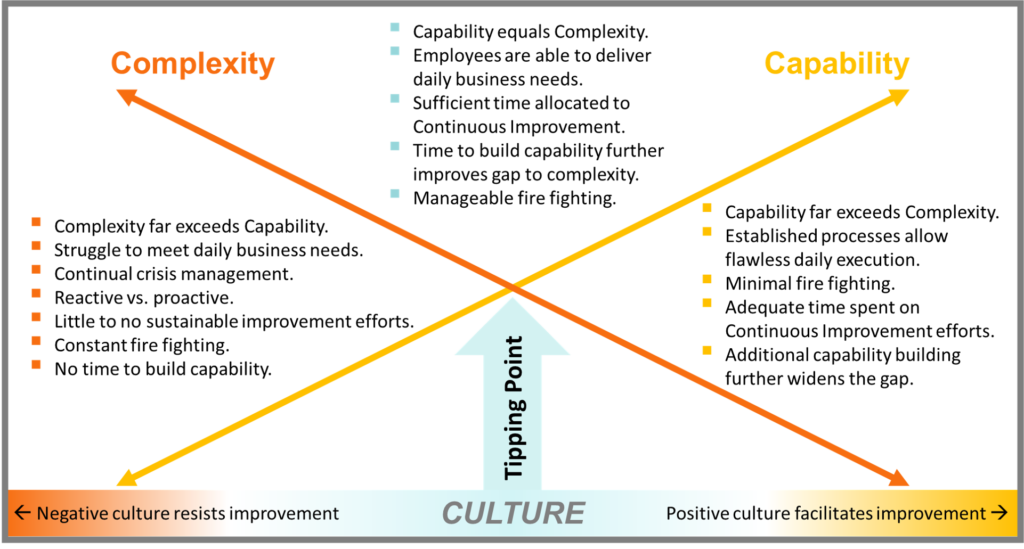April 21, 2020
The COVID-19 Challenge — When Complexity Overcomes Capability
In my nearly 40 years of Supply Chain Management I have seen and managed plants and operations with considerably different performance levels. Some struggled to deliver the basics while others were able to tackle just about any challenge and excel. This pattern was evident in every company I worked for, regardless of the industry, technology or product line. Over time, I began to appreciate the need to better understand an operation’s capability, complexity and culture. Fully understanding each of these three critical components is the key to assessing the current state and essential to improving performance. Performance excellence is achieved when capability equals or exceeds complexity. In addition, although an organization’s culture rarely creates this dynamic, it can enable or inhibit performance improvement efforts. All companies, at any point in time, have operations that sit somewhere on this continuum.
The Model

The Impact of COVID-19
Overnight, the COVID-19 pandemic has greatly disrupted the balance of every organization’s capability and complexity pushing them to the left. Complexity has increased exponentially as companies are faced with never seen before dangers. Current capability to fully address the challenge is lacking. Companies are dealing with the reality that they face SIF[1] potential for every employee, every minute of every day. They are scrambling to make sense of evolving and sometimes conflicting data and to implement and ensure adherence to new policies and procedures. In addition, many of my clients are dealing with either deep financial pressures or unprecedented product demand. The cultural challenges are also extremely formidable as employees are constantly evaluating the company’s leadership and safety commitment, concerned about their family’s safety as well as their own and continuously weighing the risk and benefit of continuing to work.
What You Should Do
It is highly likely that operations that sat left of the tipping point and were routinely in fire-fighting mode are in continual crisis and considerable trouble. It is reasonable to expect that they are completely overwhelmed by the additional complexity and lack the organizational and process capabilities as well as the cultural dynamic to adequately keep their employees safe. The leaders responsible for these people and operations need to honestly, objectively and holistically assess their risk. At the very least, these companies need to stage immediate and significant intervention efforts. In many cases, even given the operational and financial impact, they need to strongly consider ceasing operations until they can develop the capability to adequately ensure employee safety.
Those operations that were well performing and have highly engaged cultures have the foundation that they need to mitigate SIF exposure. To deal with the COVID-19 challenge, they need to take purposeful and meaningful steps to further reduce operational complexity, increase organizational capability and build and further leverage their culture. These actions include actively working to reduce complexity by cancelling all non-essential work, eliminating all non-mission critical activities, severely restricting any visitors and simplifying their product portfolios in order to reduce complexity. They also need to work equally as hard to build capability in new and existing areas. These include constant evaluation and updating of sanitation, hygiene and cleaning procedures, enhanced personal protective equipment requirements, social distancing adherence, health screening and temperature monitoring and continual risk assessment and mitigation.
Along with these critical efforts, ensuring effective leadership and high cultural engagement are of paramount importance. Employee’s expectations of leadership cannot be understated. The potential for SIF exposure has never been higher and employees are demanding that their leaders rise to the occasion. Now more than ever, leaders need to demonstrate an unwavering commitment to their employee’s well-being. Many leaders are physically isolated from their operations. As such, they need to better empower employees closest to the work in order to allow them to quickly address and resolve issues. Leaders need to be continuously mindful that their actions and not their words create culture. Ultimately, their leadership and cultural stewardship during this challenging crisis will be the difference. It will also materially shape their culture for many years to come.
[1] Serious Injury and Fatality
The COVID-19 Challenge — When Complexity Overcomes Capability
April 21, 2020
By Mark PellegriniShare this post:
Search for articles


